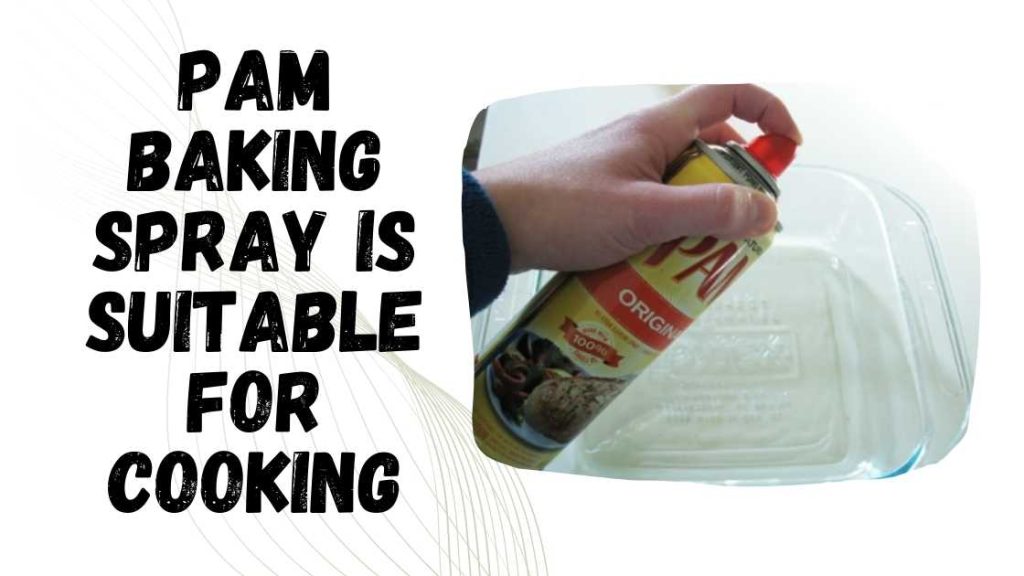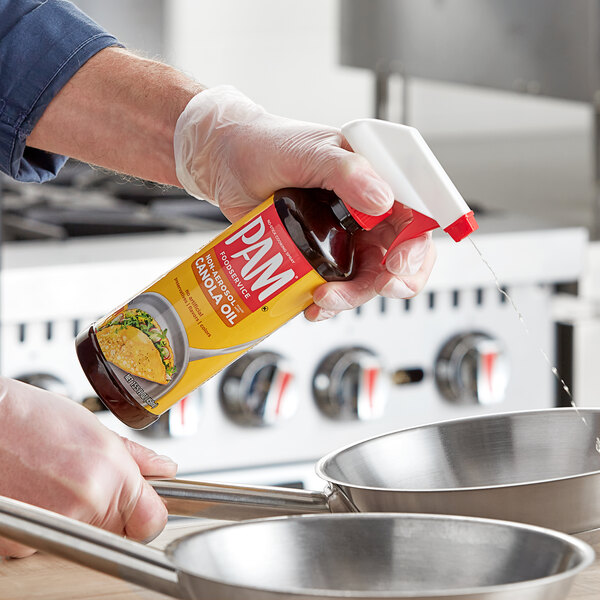Yes, Pam Baking Spray is suitable for cooking. It is specifically designed to prevent sticking and make cleanup easier for various cooking methods, not just baking.
Pam Baking Spray is a versatile product that provides a non-stick coating on cookware. It’s formulated with a blend of oils and propellants to create a fine mist that evenly coats surfaces. This is very helpful for cooking and baking because it helps prevent food from sticking to the pan, making it easier to remove delicate items like cakes and cookies.

| Feature | Pam Baking Spray | Standard Cooking Oil |
|---|---|---|
| Non-Stick Effectiveness | High | Moderate to High |
| Ease of Application | Very Easy | Moderate |
| Versatility | High | Moderate |
| Health Considerations | Lower in calories | Higher in calories |
| Suitable for Baking | Yes | Yes |
| Suitable for Frying | Yes | Yes |
What is Pam Baking Spray?
Pam Baking Spray is a nonstick cooking spray specifically designed for baking. It contains a blend of oil, flour, and lecithin, which creates a smooth, even coating on baking pans. This helps prevent baked goods from sticking, ensuring they come out cleanly and with minimal mess. It’s particularly useful for cakes, muffins, and other delicate items that can be easily damaged during removal from the pan.
Key Features of Pam Baking Spray
Pam Baking Spray is a specialized non-stick spray designed for baking purposes. It’s a non-stick spray with added flour, great for preventing cakes, muffins, and other baked goods from sticking to pans.
- Non-Stick Properties: The primary purpose of Pam Baking Spray is to create a non-stick surface on your baking pans. This helps in easy release of baked goods, such as cakes and muffins, without leaving residue behind.
- Contains Flour: The added flour in Pam Baking Spray enhances its non-stick properties specifically for baking. Flour creates a barrier between the pan and the batter, ensuring that your baked goods come out cleanly.
- Ease of Use: The spray is convenient and easy to use, saving time compared to the traditional method of greasing and flouring pans separately. Just a quick spray on the pan, and it’s ready for the batter.
- Versatility: While it’s designed for baking, Pam Baking Spray can be used for various other cooking tasks where sticking might be a concern, like coating a pan before making sticky desserts.
Using Pam Baking Spray for Cooking
Using Pam Baking Spray for cooking offers several advantages, particularly in baking and certain cooking scenarios. Here are some of the pros:
1. Non-Stick Convenience
- Easy Release: Pam Baking Spray ensures that foods like cakes, muffins, and other baked goods don’t stick to the pan, leading to clean and intact results.
- Prevents Sticking: It’s especially useful for sticky or delicate items like cookies, pancakes, or omelets, helping them slide off the pan easily.
2. Even Coating
- Uniform Coverage: The spray provides an even layer of oil and flour (in the case of baking spray), ensuring consistent non-stick performance across the entire surface of the pan.
3. Time-Saving
- Quick Application: Unlike traditional methods where you need to grease and flour a pan separately, Pam Baking Spray combines both steps into one quick spray, saving time and effort.
- Reduced Cleanup: Because food doesn’t stick, cleanup is easier, with less scrubbing needed.
Drawbacks
While Pam Baking Spray offers many advantages in the kitchen, there are some drawbacks to consider when using it for cooking. Understanding these cons can help you make more informed decisions about whether this product suits your needs.
1. Potential for Residue Buildup
One of the significant issues with Pam Baking Spray is the potential for residue buildup. Over time, if not cleaned properly, the oil and flour residue from the spray can accumulate on your cookware. This residue can lead to a sticky or greasy layer on your pans, which can be challenging to remove. Persistent buildup can affect the performance of your cookware, making it less effective at preventing sticking and potentially altering the taste or texture of future dishes.
Credit: www.webstaurantstore.com

2. Chemical Ingredients
Pam Baking Spray contains additives and propellants, such as lecithin and dimethyl silicone, that may not be ideal for everyone. While these ingredients help with the non-stick properties and ensure an even application, some individuals prefer to avoid chemical additives in their cooking due to health concerns or dietary preferences. For those seeking a more natural or organic approach to cooking, the presence of these ingredients might be a drawback.
3. Over-Spraying Issues
Another potential con is the risk of over-spraying. Applying too much Pam Baking Spray can result in an excessive layer of oil, which may affect the texture of your food. For instance, baked goods might end up with an unwanted greasy coating, or savory dishes might have an off-putting texture. Achieving the right balance with the spray can be challenging, particularly for those who are not familiar with how much is needed.
4. Environmental Concerns
Pam Baking Spray is packaged in aerosol cans, which can have environmental impacts. The production and disposal of aerosol cans contribute to environmental pollution and waste. Additionally, while some cans are recyclable, not all are, and improper disposal can lead to further environmental harm. For those concerned about sustainability, this is a notable consideration.
Alternatives to Pam Baking Spray
Those are great alternatives! Here are a few more options you might find useful:

- Oil Sprays: You can use an oil spray bottle to lightly coat your pans with your preferred oil. This can help control the amount of oil you use and provides a non-stick surface.
- Coconut Oil: Like butter or vegetable oil, coconut oil can be used to grease pans. It adds a subtle coconut flavor and is a good option for both baking and cooking.
- Silicone Baking Mats: These mats are reusable and provide a non-stick surface. They work well for baking cookies, pastries, and other baked goods.
- Non-Stick Baking Mats: Similar to silicone mats, these mats are designed for baking and can be used to line pans, reducing the need for additional greasing.
- Flour: After greasing your pan with butter or oil, you can dust it with flour. This combination can provide an extra non-stick layer, especially useful for cakes and quick breads.
Credit: www.ralphs.com
Is Pam Baking Spray Safe to Use?
Yes, Pam Baking Spray is safe to use when used as directed. It’s made from a combination of vegetable oils, lecithin, and other food-safe ingredients. These components are approved by food safety authorities for use in cooking and baking. However, it’s important to use the spray in a well-ventilated area and avoid inhaling the fumes directly.
Can I Use Pam Baking Spray for Cooking Other Foods?
Pam Baking Spray is specifically formulated for baking and may not be ideal for all cooking situations. While it can be used in a pinch for greasing pans used for cooking, it may not provide the best results for non-baked foods like meats or vegetables. For general cooking, it’s better to use regular Pam Cooking Spray or a similar product that is designed for broader cooking applications.
Does Pam Baking Spray Affect the Taste of Food?
Pam Baking Spray is designed to be neutral in flavor, so it should not affect the taste of your baked goods. Its primary function is to provide a nonstick surface without altering the flavor profile of your recipes. However, some users might detect a slight hint of oil if too much spray is applied, so it’s important to use it sparingly.
Can Pam Baking Spray Be Used on Nonstick Pans?
Yes, Pam Baking Spray can be used on nonstick pans, but it’s generally not necessary. Nonstick pans are designed to release food easily without the need for additional spray or oil. However, if you are baking something particularly sticky or delicate, a light coating of Pam Baking Spray can provide extra assurance that your baked goods will not stick.
How Should I Store Pam Baking Spray?
Pam Baking Spray should be stored in a cool, dry place, away from direct sunlight and heat sources. The can is pressurized, so it should not be exposed to temperatures above 120°F (49°C). It’s also important to keep the can upright to prevent leakage. Storing it properly ensures that the spray maintains its effectiveness and lasts as long as possible.
Is Pam Baking Spray Gluten-Free?
Yes, Pam Baking Spray is gluten-free. It does not contain wheat, barley, rye, or any other gluten-containing ingredients, making it safe for individuals with gluten sensitivities or celiac disease to use in their baking.
Can I Use Pam Baking Spray on Silicone Bakeware?
Yes, Pam Baking Spray can be used on silicone bakeware. While silicone is naturally nonstick, using Pam Baking Spray can provide an extra layer of assurance, especially when baking intricate or delicate items that might otherwise stick. Simply apply a light coating before adding your batter or dough to the silicone mold.
Final Decision
In conclusion, while Pam Baking Spray is primarily designed for baking, it can be used for cooking as well. It offers convenience, non-stick properties, and an even coating. However, it’s essential to consider the potential residue, flammability, and health concerns associated with its usage. Ultimately, the choice of whether to use Pam Baking Spray for cooking depends on personal preference and the specific requirements of your recipe.
If you decide not to use Pam Baking Spray, there are alternative options such as butter, vegetable oil, or parchment paper that can provide similar results. Experimenting with different methods will help you find the best option for your cooking needs.

I may be a little “crazy” when it comes to cooking, but I enjoy every minute of it. Spending time in the kitchen itself, whether with my family or my friends, brings me both happiness and exhilaration. This blog was created to showcase my cooking/eating with family and friends. And also as an opportunity to discuss ideas on food and the culinary circle in general.



